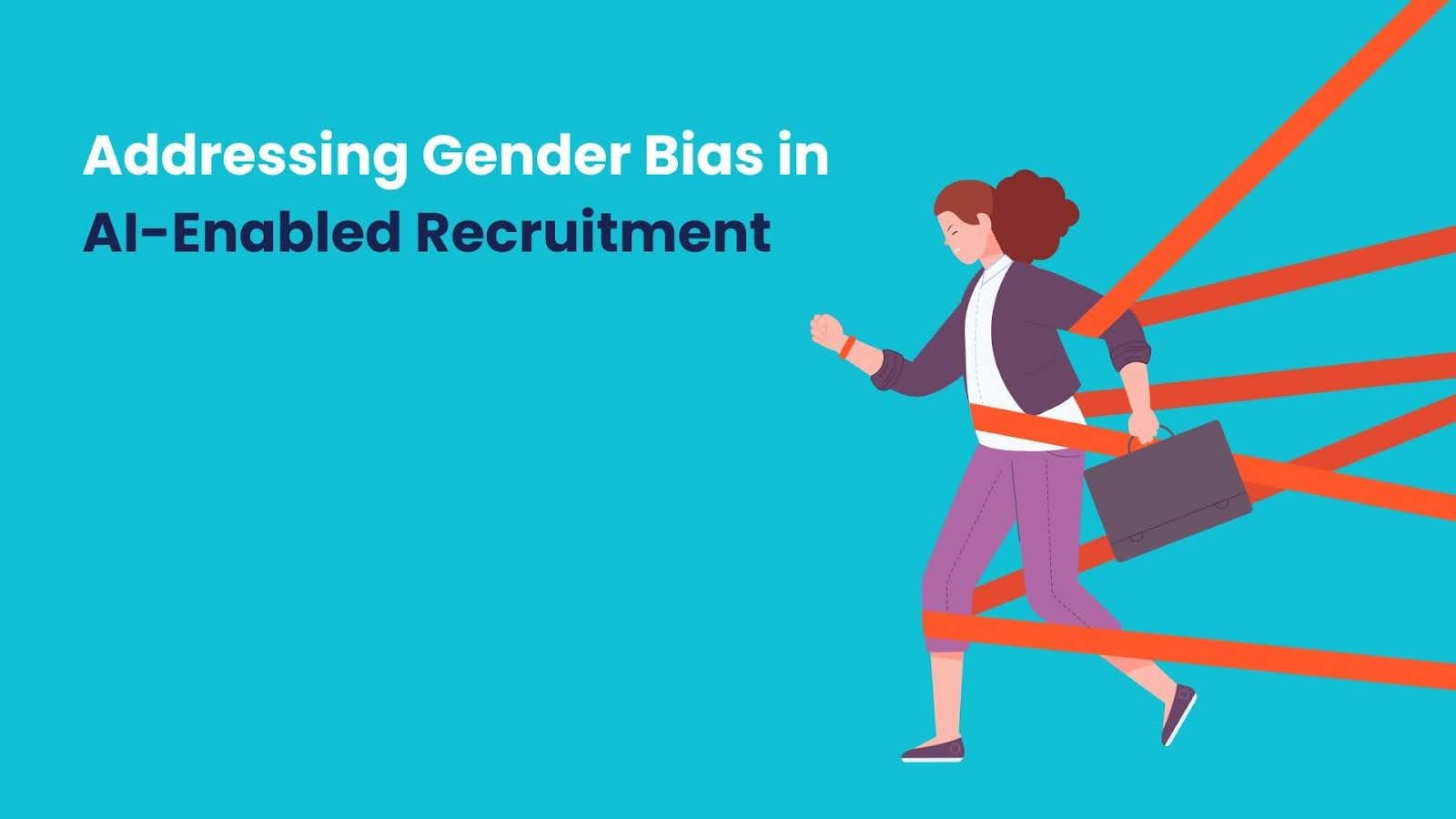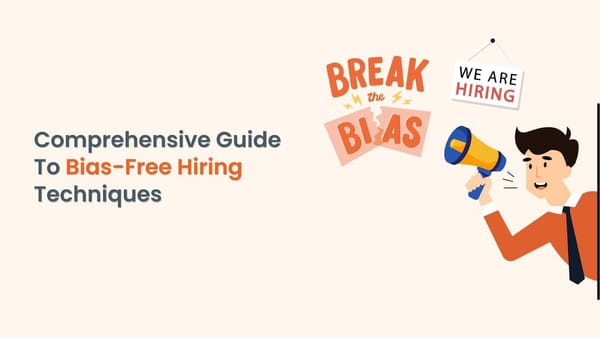AI has made recruitment faster and easier. But let’s be clear—it still has flaws.
The benefits are real, though. In fact, the Global AI recruitment market is projected to reach US$1.17 billion in 2025, with an expected annual growth rate of 26.22%. By 2031, it could hit US$4.74 billion. This shows just how quickly AI tools are being adopted, especially in hiring.
But here’s where you need to pause: while AI boosts efficiency, it doesn’t guarantee fairness.
AI hiring bias has become a real concern—particularly when it comes to gender. The very systems designed to eliminate human subjectivity can sometimes reinforce it.
However, this doesn’t mean companies should avoid AI in recruitment. It means we need to use AI smarter, with greater awareness of how bias enters the system—and how to fix it.
If you’re part of a hiring team, run an agency, or manage high-volume recruitment, this blog is built for you. You don’t need to choose between speed and fairness. With the right approach, you can have both.
Why Algorithmic Decisions Aren’t as Objective as They Seem?
It’s tempting to believe that machines don’t discriminate. After all, they don’t have feelings or personal opinions. But algorithms are only as good as the data fed into them.
Let’s break that down:
- AI learns from past hiring data—which often reflects historical gender bias.
- Job descriptions may be written in a way that subtly favours one gender.
- Resumes from male candidates may dominate training sets, skewing what “qualified” looks like.
For instance, some AI systems have downgraded resumes that include words like "women’s" (e.g., “women’s coding club”), interpreting them as less relevant. That’s a textbook example of AI hiring bias.
The biggest challenge? This bias is often invisible. By the time a human gets involved, many strong candidates—often women—are already excluded.
If the algorithms aren't perfect, why do some candidates still prefer them over humans? The psychology may surprise you.
Do Candidates Trust AI Over Humans in Hiring?
Surprisingly, many do—especially women.
A growing body of research suggests that female candidates prefer algorithmic evaluators over human ones in some cases. This preference is often linked to their past experiences with human bias during interviews.
But the story doesn’t end there. One study found that:
- Women trusted AI to be less emotionally influenced.
- Men were more sceptical, especially when the AI was replacing human judgment.
- Evaluator gender mattered—both male and female applicants reacted differently depending on who they believed was behind the decision.
This tells us something important: trust in AI isn’t universal. It’s shaped by gender, previous hiring experiences, and even cultural expectations—especially in a diverse workplace like the UAE.
Preference is one thing—actual outcomes are another. Let’s see what real experiments reveal about bias in hiring decisions.
What Do Hiring Experiments Really Show Us?
Several experiments have explored how unemployed individuals predict their chances in a job application. When faced with hypothetical hiring scenarios, some patterns stood out.
Here’s what researchers found:
- Both men and women often assumed AI would be more fair than a person.
- However, female participants consistently showed higher confidence when AI was involved.
- Evaluator gender (real or assumed) significantly influenced people’s responses.
These insights matter, especially in the UAE's multicultural job market, where perceptions of fairness can vary widely.
While confidence in AI can encourage applications, it can also mislead—if the system is biased, false fairness only deepens the problem.
Knowing there's bias is only half the battle. The real question is: can we build smarter systems to beat it?
Can We Fix Structural Bias Through Smarter AI?
Here’s the tough part: AI doesn’t create gender bias—it absorbs and amplifies what’s already there. That’s why structural discrimination can persist even when AI is involved.
One major issue is opacity. Many companies don’t fully understand how their recruitment algorithms work. Bias can lurk in the model’s training data, ranking logic, or even feedback loops that reinforce flawed results.
Common challenges include:
- Hiring algorithms penalising career gaps—often linked to maternity leave.
- Gender-coded language reinforcing male-dominated roles.
- Lack of diversity in AI training datasets.
If these problems aren’t addressed, ai hiring bias becomes harder to detect and fix. Worse, it may offer a false sense of objectivity, which prevents companies from looking deeper.
Even upgraded AI can fall short. Sometimes, only a human can catch what a dataset will never notice.
Why Human Oversight Still Matters in Hiring
Even the best AI cannot replace human insight. You need a balanced approach—one that combines human judgment with machine efficiency.
Why? Because both sides have limits:
When used together, AI can handle repetitive tasks while human recruiters focus on interpretation, emotional intelligence, and cultural fit.
But this only works if teams are trained to spot and challenge AI errors. That’s where algorithmic literacy comes in. If your hiring team doesn’t understand how your tools work, they can’t intervene when something goes wrong.
Oversight means nothing without responsibility. If we want change, someone has to own the outcome—tech won’t do it alone.
What Role Does Education and Policy Play?
Tackling ai hiring bias is not just a tech issue—it’s a governance issue. Companies in the UAE and beyond must think beyond software and invest in education, awareness, and accountability.
Here’s what helps:
- Training HR teams on how AI makes decisions.
- Auditing algorithms regularly to identify bias.
- Clear hiring policies that flag AI as a support tool—not the final judge.
The UAE is already positioning itself as a regional tech leader. That comes with responsibility. Local businesses must align with international best practices and ensure ethical AI adoption in recruitment.
Schools and universities also have a part to play. Embedding AI ethics into HR and business education can prepare future leaders to ask the right questions—and push for fairer hiring systems.
Fair Recruitment Starts with Accountability
You don’t need to ditch AI. But you do need to take responsibility for how it’s used.
Here’s what that looks like:
- Audit your hiring tools. If you can’t explain how they score candidates, that’s a red flag.
- Train your teams. Make sure HR and hiring managers know when to challenge the system.
- Demand transparency. Ask your tech vendors for clear explanations and bias testing reports.
- Stay informed. Gender bias in AI is evolving—so should your approach.
Above all, remember this: fair hiring isn’t just about filling roles—it’s about building trust. In a fast-growing, diverse market like the UAE, trust is everything.
Now that we’ve unpacked the challenges, let’s talk about solutions—and how TidyHire is quietly changing the game.
How TidyHire Supports Smarter, Fairer AI Hiring?
TidyHire directly addresses many of the concerns around AI hiring bias—while keeping the recruitment process efficient and scalable. Here’s how it helps:
1. Fairer Sourcing with Massive Reach
TidyHire’s Recruiting Intelligence Agent (RIA) searches across 700+ million profiles from 30+ sources. This breadth ensures recruiters don’t rely on a narrow talent pool, reducing the risk of excluding qualified candidates based on biased algorithms or limited datasets.
2. Bias-Reducing Automation
RIA handles sourcing, follow-ups, and communication through AI-generated, hyper-personalised messaging. Instead of using one-size-fits-all templates, it tailors outreach to the individual—minimising stereotypes that often appear in generic, biased scripts.
3. Human Oversight, Built In
With Xceptional Recruiters, hiring teams can combine automation with real human insights. This hybrid model ensures AI decisions are always balanced with expert judgment—essential in tackling unconscious bias.
4. Data-Driven Improvements
Recruiters get daily reports and real-time analytics on candidate engagement and campaign performance. This allows you to quickly spot if the system is consistently favouring or filtering out certain groups—so you can fix it fast.
5. Personalisation at Scale
AI helps with bulk hiring without losing the human touch. By automating repetitive work, recruiters can focus more on candidate experience, relationship-building, and evaluating fit—areas where human thinking is still critical.
6. Full Integration for Workflow Clarity
TidyHire integrates with tools like Slack, Microsoft Teams, and ATS systems. This streamlines communication across teams, ensuring transparency and collaboration—two key factors in making hiring decisions more equitable.
Conclusion
AI is reshaping recruitment, but AI hiring bias remains a real challenge. Instead of avoiding AI, the goal is to make it work better—fairer. This blog helps you spot risks, apply safeguards, and combine human judgment with smarter tools.
That’s where TidyHire comes in. It simplifies outbound hiring, automates repetitive tasks, and keeps your outreach personal and inclusive—helping your team hire faster and smarter.
Ready to experience recruitment done right? - Take a Demo Tour Today!


